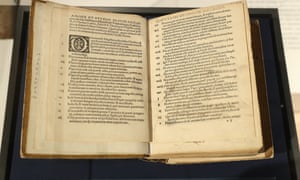
The Guardian Tuesday 31 October 2017
Catholic and Protestant leaders will stress their mutual bonds 500
years after the start of the Reformation, a movement which tore apart
western Christianity and sparked a string of bloody religious wars in Europe lasting more than a century.
A service in Westminster Abbey on Tuesday will mark the anniversary
of the date in 1517 on which the German theologian Martin Luther
submitted The 95 Theses to the archbishop of Mainz as well as nailing a
copy to the door of a church in Wittenburg, lighting the fuse of the
Reformation.
The archbishop of Canterbury, Justin Welby, will present a text by
the Anglican communion affirming a joint declaration by the Roman
Catholic church and global Protestant bodies described as “a sign of healing after 500 years of division”.
Last week, Pope Francis said
Catholics and Protestants were now enjoying a relationship of “true
fraternity” based on mutual understanding, trust and cooperation.
He told Derek Browning, moderator of the Church of Scotland, who was visiting the Vatican
as part of the Reformation commemorations, that the two traditions were
“no longer … adversaries, after long centuries of estrangement and
conflict”
The pontiff added: “For so long we regarded one another from afar,
all too humanly, harbouring suspicion, dwelling on differences and
errors, and with hearts intent on recrimination for past wrongs.”
The 95 Theses, written in Latin, was a backlash against increasing
corruption in the Catholic church and, in particular, the highly
profitable sale of “indulgences”. These promised a fast-track to heaven
and were sold to fund the building of St Peter’s Basilica in Rome.
Luther argued that salvation could not be bought or brokered by the church, but was a matter between an individual and God.
His challenge to the authority and elitism of the Catholic church was
translated into German and other European languages. Thanks to
revolutionary new printing presses, his message spread rapidly and was
taken up by others, including the French theologian John Calvin.
Rome condemned Luther as a heretic and launched the
Counter-Reformation, but by the end of the 16th century most of northern
Europe was Protestant.
In England, Henry VIII, desperate to dissolve his marriage to
Catherine of Aragon in pursuit of a male heir, launched his own, less
clear-cut, separation from the Catholic church which involved the
destruction of much of the country’s religious heritage.
In 1999, the Catholic and Lutheran churches agreed a “joint
declaration on the doctrine of justification” that resolved many of the
theological issues at the heart of the schism. This document has now
been welcomed and affirmed by the Anglican communion.
A spokesperson for the Catholic church in England and Wales said:
“The desire for reconciliation is such that mistakes can be recognised,
injuries can be forgiven and wounds healed.
“We give thanks to the joy of the gospel we share as Christians,
express repentance for the sadness of our divisions and renew our
commitment to common witness and service to the world.”
But despite the warm words of reconciliation issued by leaders, there
are issues blocking the prospect of a reunification of the two
traditions, not least that of female priests.
Meanwhile, pockets of sectarianism remain in parts of northern Europe, including Northern Ireland and Scotland.
Last year, a document
released by an evangelical Protestant group, Reformanda Initiative,
drew a distinction between individual Catholics and the “unchecked
dogmatic claims and complex political and diplomatic structure … [of
the] the institutional Catholic church”.
It concluded: “The issues that gave birth to the Reformation 500
years ago are still very much alive in the 21st century for the whole
church.”
No comments:
Post a Comment